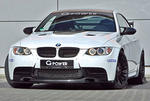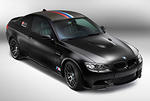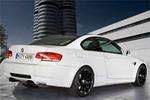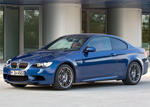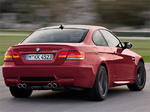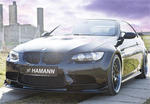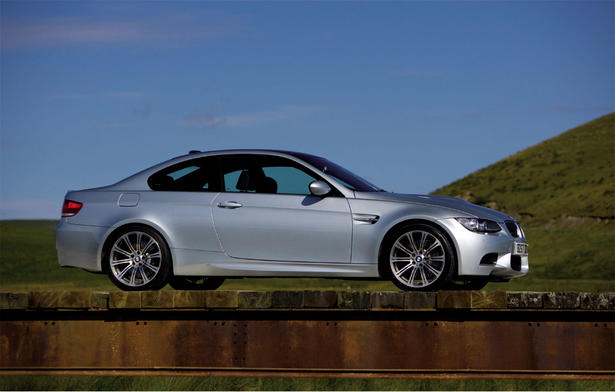
BMW has released the details of the right hand side drive 2008 BMW M3 Coupe that will be sold in Great Britain, and probably in all the other right hand side drive countries. The 2008 BMW M3 Coupe has 420 hp and 400 Nm of torque, accelerates from 0 to 62 mph in 4.8 seconds and has a top speed of 155 mph which is Electronically-limited.
The new E92 BMW M3 will be available at the UK car dealerships starting from the 8th of September, 2007, and will cost £50,625 OTR.
BMW Press Release:
M3 – The rebirth of an icon
M3. Just a single letter and number. But it elicits a hugely emotional resonance with UK car enthusiasts. When the first BMW M3 was shown at the Frankfurt Motor Show in 1985 it spawned an entirely new segment of the market. Many have tried to copy the award-winning formula of unsurpassed driving dynamics and intelligent engineering combined with day-to-day practicality and understated performance.
BMW aims to maintain its class-leading position with the new, fourth generation, BMW M3 Coupe.
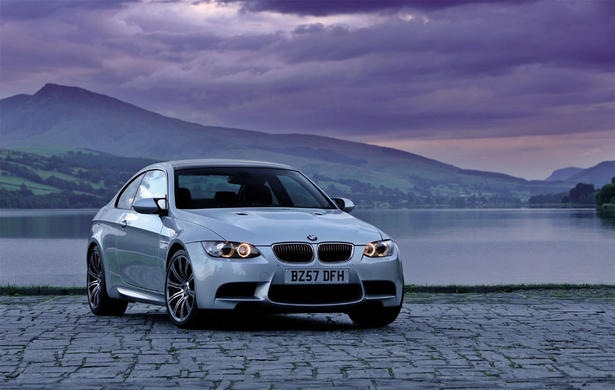
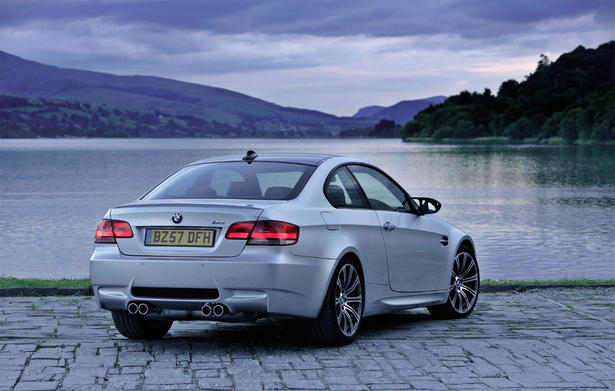
It is the most powerful production M3 ever produced, featuring a lightweight 420hp eight-cylinder engine while introducing elements from BMW’s EfficientDynamics programme that, in combination, delivers a cleaner, more frugal, compact supercar.
Power is transmitted to the road via a six-speed manual gearbox and the BMW variable M differential lock. The short gear lever and close gate encourages swift, positive changes. The variable M differential uses a torque-sensing differential lock to channel power to the rear wheel that can transmit the most traction.
This unique differential really excels in cornering or on slippery road surfaces.
The new BMW M3 Coupe delivers rapid straight line speed with zero to 62mph attained in 4.8 seconds and an electronically-limited 155mph top speed.
Model / Price OTR / Power Hp / Torque Nm / 0 – 62mph Seconds / Top Speed Mph / Combined Mpg / CO2 g/km
BMW M3 Coupe / £50,625 / 420 / 400 / 4.8 / 155* / 22.8 / 295
*Electronically-limited
The BMW M3 Coupe is the first M product to feature EfficientDynamics technologies. Consequently the car is eight per cent more fuel efficient than the outgoing model recording 22.8mpg on the combined cycle. Emissions have also been cut by nine per cent from 323g/km to 295g/km. The M3 Coupe is helped in achieving these figures courtesy of Brake Energy Regeneration, one of the elements of BMW’s EfficientDynamics programme. Previously engine power produced during deceleration was lost, but now it is recycled to charge an Absorbent Glass Mat battery. Conversely, under acceleration,
the alternator decouples to avoid being a drain on engine performance. An optimum gear change indicator in the instrument binnacle can help cut fuel consumption further as it advises the driver of the optimum gear to choose for economical motoring.
One strand of the EfficientDynamics ethos employed on the new M3 Coupe is the extensive use of lightweight technology. The most obvious sign of this is the carbon fibre reinforced plastic roof. A first for the segment, the roof saves 22kgs over a conventional steel roof with a sunroof fitted and is made at BMW’s Landshut foundry; the same location at which engine block is produced for the BMW Sauber F1 team. The roof also serves to lower the car’s centre of gravity for better balance.
The unique carbon-fibre reinforced plastic roof is just one element that aids the car’s chassis set-up and impressive dynamic capabilities. The new M3 Coupe features a bespoke suspension configuration and construction. To save 2.5kgs in weight without compromising rigidity, nearly all of the components in the front double joint spring strut suspension are made from aluminium. All of the components in the five-link rear axle suspension, except for one track control arm, are also made of aluminium. Other lightweight materials used include thermoplastics for the bumpers and front wings, and a bonnet made of aluminium.
The driver of an M3 Coupe is supported by the most sophisticated and advanced stability control systems in the automotive world. Dynamic Stability Control + provides a welcome electronic safety blanket and is a system that can be fine-tuned to suit driving style. DSC+ includes the functions of traction control, Anti-slip + Traction, Corner Brake Control and adds further features to improve wet braking performance, smoothness of braking and hill starts.
For those drivers wishing to experience the dynamic capabilities of the new M3, MDynamic Mode can be selected via the iDrive menu. MDynamic Mode permits a greater degree of performance and wheel slip before the DSC+ system intervenes. While this has a practical benefit for slow speed starts on slippery surfaces such as snow and ice, its real function is to allow spirited driving with maximum driver involvement.
Available as an option, Electronic Damper Control (EDC) allows three different stages of ride set-up – Comfort, Normal and Sport – selected manually via a button adjacent to the gear lever. For a greater degree of personalisation the throttle and steering sensitivity can also be changed using the Power button, located alongside the EDC button.
MDrive Manager offers owners the optimum in M car personalisation. It enables all the configurations of EDC, DSC+ / MDynamic Mode, throttle and steering response to be preconfigured by the driver. Once set-up, the driver needs only to press the steering wheel-mounted M button to select his preferred driving configuration. Of course, as the driver spends more time in the car, the configurations can be changed to suit new requirements.
While the basic silhouette of the M3 Coupe resembles the standard 3 Series Coupe, BMW M’s bespoke design ethos ensures that 80 per cent of the parts differ from the standard model. Apart from the car’s actual structure, only the doors, boot lid, windows and front and rear lights are carried over. All other components have been tailor-made for the M3 Coupe.
The BMW M3 Coupe has grown marginally in all dimensions compared to the previous model yet it has near-identical aerodynamic efficiency. The heavily sculptured front has been designed to channel up to 400 litres of air per second into the engine. The purposefully-styled spoiler and sculpted wing mirrors create additional downforce for even better road holding. At the rear, the quad exhaust pipes protrude in pairs on either side of a small venturi, while a discreet rear spoiler on the bootlid provides yet more downforce.
Inside, front seat occupants are cocooned in deeply contoured sports seats equipped with full electric adjustment. The two rear seats are divided by a central storage binnacle and are designed to accommodate two adults in comfort, while the 430-litre boot is capable of swallowing the luggage of four people.
Jim O’Donnell, managing director of BMW (UK) Ltd, said: “The now-iconic M3 created an entirely new market niche back in the mid-1980s and each successive incarnation has been warmly welcomed by aficionados of sporting cars.
“All our competitors have recognised the market opportunity in this sector, but I am sure that BMW has reset the benchmark higher for all of them. I am very confident that the M3 will be a great success in the UK.”
Racing heritage
The original M3 was created to go racing and each subsequent version has maintained these championship-winning credentials. The E30 M3 scooped more than 1,500 individual victories and more than 50 international championship titles in its lifetime and remains the most successful Touring Car of all time. The 2.3-litre, and subsequent 2.5-litre four-cylinder, powered models were loved by customers and were equally successful in the market. The original planned production of 5,000 to meet FIA regulations topped 18,000 by the time the first M3 stopped production.
The E36 M3 picked up where the E30 model left off. The 3.2-litre straight-six cylinder car with 286hp was launched in 1992 and was offered for the first time in Saloon as well as Coupe and Convertible forms, but the Coupe remained the most popular. The E36 M3’s engine was uprated in 1995 to 321hp and a six-speed gearbox was introduced. BMW offered the first production Sequential Manual Gearbox (SMG) in 1997 and it became popular with buyers; 50 per cent of M3 owners ordered the SMG system. During the era of the E36 M3, FIA regulations meant the car was ineligible for some championships - that honour fell to the highly successful four-cylinder-powered 320i. The E36 M3 still won titles in America as well as endurance races on both sides of the Atlantic and rally and hill climb championships.
The E46 model truly reinforced the M3 as the class leader when it was launched in 2000. Its 3.2-litre six-cylinder engine now produced 343hp and, with its enhanced chassis and dynamic capabilities, saw off rival product with ease in both Coupe and Convertible form. The introduction of the M3 CSL upped the ante with its extensive use of aluminium and composite panels, an engine performance boost to 360hp and bespoke tyres. The CSL was a real racer for the road. An M3 CS closed the E46 M3 chapter and catered for those wanting the performance brakes and other CSL enhancements but without some of the more extreme and costly weight-saving features.
The new E92 BMW M3 goes on sale in the UK on 8 September, 2007, and costs £50,625 OTR.
Key facts
- Most powerful road-going M3 ever.
- First production M3 to be powered by a V8 engine.
- First time that a BMW M3 has EfficientDynamics fuel-saving and emissions-reducing technology. Brake Energy Regeneration and optimum gear shift indicator cut CO2 emissions by nine per cent and improve fuel consumption by eight per cent.
- First road-going BMW M3 to be offered with an optional adjustable suspension.
- The BMW M3 is the only car in its segment to have a carbon fibre roof. The roof saves 22kgs compared to a conventional steel construction incorporating a sunroof and lowers the car’s centre of gravity.
- The engine, cast in BMW’s Landshut light alloy foundry alongside the BMW Sauber F1 team’s powerplants, is 15kgs lighter than the six-cylinder engine it replaces.
- The M3 features the most advanced production car engine ECU in the world capable of 200 million calculations a second.
Drivetrain
The heart of every BMW M3 lies under the bonnet and the new model is no exception. The new M3 is first to feature an eight-cylinder engine and also the most powerful. Like its predecessor and all BMW M cars, the new V8-powered BMW M3 Coupe easily beats the magical 100hp per litre benchmark by achieving 105hp per litre.
A look at the figures recorded by the M3 Coupe engine reveals a powerplant capable of impressive performance statistics. It develops 420hp (77hp more than its forebears) at 8,300rpm and 400Nm of torque at 3,900rpm from its 3,999cc powerplant. To highlight its flexibility, 85 per cent of torque is available from 2,000rpm through to 8,400rpm. This M3 is as happy making smooth progress at city speeds yet offers effortless top end performance when required.
This all-new V8 engine powers the car from zero to 62mph in 4.8 seconds before going on to an electronically-limited top speed of 155mph. However, these supercar levels of performance do not compromise economy, with the car still delivering 22.8mpg on the combined cycle - an eight per cent improvement over the outgoing car. CO2 emissions have also been cut from 323g/km to 295g/km compared to the outgoing model.
To ensure optimum engine efficiency BMW’s engineers incorporated variable valve technology on the M3 powerplant. BMW’s renowned Double-VANOS valve timing system is used to determine when individual valves open and close for the perfect alignment of intake and outlet on the combustion cycle. Individual throttle butterflies for each cylinder, combined with high-performance engine electronic systems, also ensure smooth running at all speeds combined with high power output.
Formula One heritage
The eight-cylinder engine in the BMW M3 Coupe can trace its lineage to BMW’s involvement in Formula One. Its racing pedigree harks back to the start of the marque’s most recent foray into motorsport’s ultimate series with a V10 engine in the BMW Williams F1 Team in 2000. Long before this, BMW was an engine partner to Brabham who used the four-cylinder 1.5-litre turbocharged units to win the FIA World Championship in 1983 with Nelson Piquet at the helm.
BMW engineers have learned much from testing and racing at the pinnacle of motorsport and this paid dividends with the introduction of the 5.0-litre V10-powered BMW M5 and M6 models. New Formula One regulations came into force in 2006 and BMW Sauber F1 moved from a V10- to a V8-powered car.
This change encouraged BMW engineers to develop a similar configuration for the new M3. In fact the design principles of the new V8 engine are so close to those of the M5 and M6, technology itself gained from the early BMW V10 F1 days, that they share nearly 80 per cent of their engine parts. The castings of both the 5.0-litre V10 and 4.0-litre V8 powerplants originate from BMW’s Landshut foundry, the same production facility where BMW Sauber F1 team’s engines are cast.
Like the engine powering the BMW Sauber F1 car, the new V8 in the M3 Coupe is engineered to extremely fine tolerances. At full power the pistons in a Formula One car are moving at 25 metres per second. By contrast the pistons in the M3 Coupe travel at approximately 20 metres per second.
To give an idea of the stresses placed on the engine’s moving parts, at full power the valves are subjected to 1,600g acceleration on opening and 500g deceleration prior to closing again. To bring this into perspective, if a car could accelerate and brake with the same force, it would travel from zero to 62mph in just 0.0017 seconds in a distance of 25cms. Continuing the analogy, if a car was travelling at 155mph and braked with this force, it would come to rest in 50cms.
Clearly such figures are in the realm of fantasy, but BMW engineers have designed the components of the M3 Coupe to sustain such forces. One must also consider that while a Formula One engine is rebuilt after every other race weekend, the one powering an M3 Coupe is expected to last many years.
To cope with such stresses special materials are used in the construction of the engine. The cylinder crank case is made of lightweight aluminium silicon alloy and the cylinder bores are lined with hard silicon crystals which allow the iron-coated pistons to run without cylinder liners. Hard silicon crystals are also used to protect the alloy crank case against wear.
Electronic excellence
The MS S60 electronic control unit managing the engine is another feature that shares much with the M5 and M6. One of the most advanced engine management systems currently available, the MS S60 was designed and built in-house by BMW and is made up of more than 1,000 individual components. It controls all functions of the engine via three 32-bit processors that are capable of performing up to 200 million individual calculations per second. Compared to the ECU in the previous E46 M3, the computing power in the new car is eight times more powerful and has 10 times more memory capacity.
Impressive figures that, in short, translate to an engine which now performs a near perfect combustion cycle.
The MS S60 also manages:
- The electronic throttle valve control on a power and torque matrix according to a potentiometer on the accelerator pedal. This meets the driver’s demand for power and performance. The power and torque manager adjusts requests by adding power signals from auxiliary engine units such as the air conditioning compressor.
- Functions such as idle speed control, emission control and knock control are also coordinated and aligned to the maximum and minimum output, and torque curves are controlled by DSC and Engine Drag Force Control.
- Comprehensive on-board diagnosis for use by BMW service engineers.
- New and innovative ionic current technology to manage engine ‘knock’, misfiring and combustion ‘misses’.
Lightweight technology
The engineering purity displayed in the BMW M3 Coupe has been enhanced by intelligent design and the use of advanced lightweight components. The engine block of the new M3 weighs just 202kgs, 15kgs lighter than the previous M3’s six-cylinder engine. This has been made possible by the increased use of aluminium in the engine block and ancillary systems attached to the unit. Engineers have saved weight by altering the size of some parts. As an example, each connecting rod now has a trapezoid structure at one end as opposed to a larger, heavier, squared-off end. Not only has this saved weight but it has led to a reduction in the moving forces within the engine. The crankshaft in the new engine is made from one complete forging and weighs only 20kgs. The M3’s V8 engine now sits lower and further back within the chassis compared with the previous car which delivers better all-round weight distribution.
Fuel saving technology
Brake Energy Regeneration plays an integral part in the way the new BMW M3 achieves the diametrically opposed goals of increased power and performance, and improved fuel economy and lower emissions. The system serves to enhance all-round drivetrain efficiency by preserving electrical energy generated when the engine is running and the car is braking.
This highly efficient energy management process exploits normally wasted energy and is made possible by the intelligent control of the alternator. Specific on-demand generation of electrical energy (i.e. the alternator only works when needed) serves to reduce fuel consumption because the alternator disconnects when the engine is running under load. With this reduction in direct generation of electrical power, more engine potential is available for acceleration.
BMW has combined Brake Energy Regeneration technology with AGM (Absorbent Glass Mat) batteries to allow for this intelligent power generation. AGM batteries are able to withstand the increased number of intermittent charging phases that occur with a conventional lead acid battery. In an AGM battery, the acid is held in micro-glass-fibre mats between the individual layers of lead. Thus the battery is able to store energy over a long period even when regularly charged and discharged.
Aerodynamic efficiency is not only important outside the car, it is also critical inside the engine and gas flow technology was an important part of the new M3’s engine design. The unique design of the intake system mimics the addition of a supercharger – the intake ducting and the valve housing in the cylinder head actually forces 10 per cent more fuel-air mixture into the combustion chamber on each cycle. This improved combustion and more complete ignition process creates a greater downward thrust on the piston. Such is the efficiency of engine breathing that at peak revs the engine swallows 400 litres of air per second without any undesirable back pressure.
The BMW M3 comes with a specially-designed wet sump lubrication system to ensure all the moving mechanical parts of the engine work to optimum efficiency. Race car engines usually come with a dry sump, partly to lower the height of the engine within the car but also to prevent oil starvation during high speed cornering. However, the unique design of the M3’s oil channels, and its wet sump, mean such an arrangement can still be used without the risk of oil starvation during acceleration, braking and cornering. Even with lateral forces of 1.4g, greater than those acting on you when taking off in a jet aircraft, the engine’s oil supply remains constant. This move also saves weight because the pump required by a car fitted with a dry sump is no longer needed to shift oil around the block.
Exhaust
The BMW M3 Coupe is fitted with a unique exhaust system that helps deliver maximum power and torque. Constructed by a 800 bar high-pressure moulding process that shapes the stainless steel exhaust pipes, the walls of the exhaust system are extremely thin – less than 1mm. Not only does this save weight, but it also minimises flow resistance of the exhaust gases and improves engine breathing. The response of the four catalytic converters is boosted by this uninterrupted flow.
All of these power, technology and lightweight innovations combine to allow the new BMW M3 Coupe to set a new benchmark for ‘standard’ M3 cars. The outgoing M3 was capable of an 8mins 15secs lap of the northern loop of the Nurburgring’s Nordschliefe. An official lap time for the V8-engined M3 Coupe has yet to be announced, but during development it was apparent that a figure closer to eight minutes dead is achievable.
Transmission
Power is transferred to the road by BMW M’s six-speed manual gearbox. The transmission’s short throw and close gearbox gate, developed in conjunction with German specialist GETRAG, ensures quick, precise manual gearchanges.
The variable M differential lock
To ensure that all the power developed by the 4.0-litre V8 engine is transferred to the road, the new M3 features a variable, torque-sensing differential lock developed by M GmbH. This provides the vehicle with a high level of driving stability and optimal traction, especially when cornering.
Unlike a normal limited slip differential with a 25 or 50 per cent locking capability, the variable M differential lock can, in extreme conditions, provide up to 100 per cent locking. This means that when one of the rear wheels loses traction on a more slippery part of the road, or when the inside wheel spins on very tight bends, the M3’s differential will ensure that the drive shafts send the correct amount of drive to the wheel that is able to transmit power to the road.
When a driven rear wheel threatens to lose traction, pressure is generated in an integrated shear pump. This pressure is transferred to a multiple-disc clutch via a piston. In this way drive forces are directed to the wheel with better grip as determined by the difference in the rotational speed of the wheels. When the difference in rotational speed decreases, the locking action diminishes.
The advantages of the variable M differential lock are:
- 0-100 per cent drive force can be delivered to either driven wheel.
- On snow, gravel or ice a conventional torque-sensing differential does not offer enough flexibility. The variable M differential provides a substantial advantage when the driven wheels are subject to greatly varying coefficients of friction.
- When combined with a finely tuned DSC+ system and a near 50/50 weight distribution, this differential lock helps the car to excel in very slippery conditions.
- The system delivers rewarding handling on roads with average to high frictional coefficients.
- It combines safety, stability and driving pleasure.
Chassis
The BMW M3 Coupe features an advanced chassis configuration that, for the first time in a BMW M3, is available with a degree of active suspension. It is also the first M3 to be equipped with Dynamic Stability Control + (DSC+) - the most advanced automotive stability control.
The M3’s Electronic Damper Control (EDC) allows the driver to adjust the suspension compliance depending on the style of driving. Three settings are available – Comfort, Normal and Sport – and changes can be made via the EDC button located on the transmission tunnel. Alternatively the MDrive Manager function can be used to set the damper requirements with activation occurring via the MDrive button on the steering wheel.
EDC is a continuous and variable electronic damper control. In ‘Normal’ mode the damping is automatically adjusted to achieve the optimum balance between Comfort and Sport. In ‘Sport’ mode the damping is firmer and employs higher damping forces, thereby reducing lift.
In ‘Comfort’ mode EDC produces lower damping forces in favour of greater ride comfort. EDC is available as a £1,295 option.
To reduce unsprung weight and improve ride comfort, the BMW M3 Coupe features a front suspension predominately composed of aluminium. Within the double-joint front axle arrangement, the struts, pivot bearings, central subframe and an additional thrust panel are made of the lightweight yet strong metal. All of the components in the five-link rear axle suspension, except one track control arm, are also made of aluminium. Such attention to detail by the M division serves to reduce weight by 2.5kgs per corner of the car compared to a more conventional steel suspension system.
The best in stability control
The new BMW M3 comes with the most advanced stability control system currently available. DSC+ represents the pinnacle of active safety and dynamic capability, but it has been subtly refined for use on the M3 Coupe. Although DSC + can be switched off completely, it has two programme levels depending on driver requirement. The first corresponds with the set-up of a ‘standard’ BMW road car and offers a near complete electronic safety blanket that includes traction control, Anti-slip + Traction and Corner Brake Control.
The second stage of DSC+ is called MDynamic Mode and it will appeal to the sport-oriented driver. This programme is pre-selected using the MDrive menu and can be called up by pressing the MDrive button on the steering wheel. MDynamic Mode allows for a greater degree of wheelslip without the interruption of the DSC+ safety systems retarding power or braking individual wheels.
MDynamic Mode compares with the Dynamic Traction Control function exhibited on other BMW products except that the parameters of this system are tuned to cater for more advanced or ambitious drivers. The driver is informed of MDynamic Mode by the illumination of a light on the driver’s instrument cluster marked ‘MDM’.
The BMW M3 features four further functions of Dynamic Stability Control to give it its DSC+ credentials:
- Hill-start Assistant provides what is effectively a momentary electronic handbrake that holds the car on an incline for two seconds. This allows the driver to engage gear and find the clutch biting point to pull away smoothly without rolling backwards.
- Soft-stop releases a degree of braking pressure when coming to rest in an M3 to achieve a smooth stop.
- Brake Drying works by gently applying the brake pads to the discs in wet conditions to clear the film of water that can build up. This keeps the discs and pads ready for more effective braking performance.
- Brake Pre-tensioning recognises if the driver’s foot comes off the accelerator in preparation for an emergency stop. When this occurs the brakes are partially activated so that the pads are in mild contact with the discs ready to be fully applied when the brake pedal is pushed. This helps shorten stopping distances.
Brakes and bespoke tyre and wheel combination
For a car with the performance capabilities of a BMW M3 Coupe the very highest levels of braking power are required. The compound front discs measure 360mm x 30mm and are vented and cross drilled for greater heat dissipation, while a single piston swing-calliper and pad provides the bite. The rear brakes measure 350mm x 24mm and are vented and cross drilled discs with single piston swing-callipers and pads. This high technology stopping power results in the M3 Coupe coming to a halt from 62mph in just 34 metres – 21 metres less than the Highway Code figure for a car travelling at 60mph.
The M3 Coupe comes as standard with graphite-coloured light alloy wheels in a unique multi-spoke M design. The front wheels measure 8.5 x 18-inch and are shod with 245/40 ZR18 Michelin tyres. At the rear, 9.5 x 18-inch light alloy wheels accommodate 265/40 ZR18 tyres.
Michelin Pilot Sport PS2 tyres were developed specifically for the BMW M3 Coupe. They incorporate two fundamental technologies that aid its performance: an asymmetric tread pattern and a Variable Contact Patch that adjusts the amount of rubber in contact with the road depending on the manoeuvre.
The asymmetric tread pattern allows high levels of grip and feedback on both dry and wet roads. The Variable Contact Patch permits a greater degree of cornering grip compared to previous performance car tyres. It does this by maintaining the same area of contact patch despite the extreme stresses caused by tyre loading when cornering.
The M3 Coupe's tyres feature a mix of three bespoke tread compounds. The outer half of the tread on the front and rear tyres is made from a carbon-black compound for durability under hard cornering and helps resist excessive shoulder wear. The inner tread area of the rear tyre features a pure silica compound for high levels of grip in wet and dry conditions, while the inner tread of the front tyre has a hybrid carbon-black/silica compound to induce mild understeer on the limit. This combination ensures high levels of driver safety by reducing the risk of sudden oversteer when cornering.
The tyres have also been subjected to a weight reduction programme and the front Michelin Pilot Sport PS2 tyres tip the scales at 10.6kgs each while a rear weighs 11.5kgs. In comparison no other performance tyre can match the weight of the bespoke Michelin Pilot Sport tyres fitted to the BMW M3.
Bespoke M steering
For the first time a BMW M3 Coupe driver can choose the level of assistance in his steering depending on his or her driving preferences. The rack and pinion hydraulic steering is equipped with a Servotronic system featuring two manually preselectable electronic control maps for differing rates of assistance and feel. To select this function a driver uses a menu within iDrive to choose between Normal or Sports mode. Normal mode has a greater level of assistance for a more relaxed driving style while Sports mode has less for a more direct feel.
The system is not to be confused with BMW’s innovative Active Steering technology which features a planetary gear intersecting the steering column to alter the steering ratio of an equipped car.
Design
At first glance the BMW M3 Coupe bears a close initial resemblance to ‘standard’
3 Series Coupe models. However, a number of subtle performance enhancements deliver an unmistakably sporting form. In fact, almost 80 per cent of all components on the M3 are different. Only the headlights, rear lights, the windows, the doors and rear bootlid have been carried over.
A striking powerdome hints at the performance of the V8-powered M3 while two air vents are situated towards the rear edge of the aluminium bonnet. One of these is a working vent to help with engine cooling. Primarily, the design of the front is created by the need to force significant volumes of air into the induction system. When the engine is running at full power, 400 litres of air per second are channelled to the intake system. As a result, three large air ducts in the front lower valance keep the engine breathing.
In profile, the new M3 Coupe features 18-inch double-spoke light-alloy wheels as standard, with a striking 19-inch forged and polished wheel available as an option. Another BMW M trait, a side gill in the front wing, also includes the side direction indicator and the M3 logo. Such is the performance of the new car that even the exterior door mirrors enhance the aerodynamic characteristics and provide more downforce.
From the rear, an aerodynamically-efficient diffuser emphasises BMW M’s trademark twin double exhaust pipes that protrude from beneath the valance. The boot lid also features a discreet rear spoiler that provides an additional level of downforce.
World first in carbon-fibre use
BMW first experimented with a carbon-fibre reinforced plastic roof when it used the technology for the M3 CSL. Since then it has refined the production process to make it easier to manufacture and fit in with the production requirements of a larger scale production cycle.
Now, the new M3 Coupe is the first full production car in its class to feature a carbon-fibre-reinforced plastic roof panel. In isolation, the carbon-fibre roof panel saves 22kgs over a conventional roof panel fitted with a sunroof but it also lowers the centre of gravity to contribute to the M3’s benchmark driving dynamics.
The roof of the new M3 Coupe starts life as individual layers of woven and non-crimped carbon fibre fabric. These layers are placed on top of each other and are then pre-formed together in an automated process. The so-called pre-form is then placed in a closed steel-tool, where a strong bonding epoxy resin is applied to bind the layers together. A clear top coating was chosen as opposed to a matching paint colour so that the intricate weave of the M3 Coupe’s roof could be kept visible to highlight the unique construction of the car.
Dimensions
Compared to the outgoing M3 Coupe, the fourth generation model has grown in size. It is 123mm longer at 4,615mm, 24mm wider at 1,804mm and 35mm taller at 1,418mm to create greater interior space for occupants. However, the generous dimensions have not had a noticeable impact on the aerodynamic efficiency of the car.
Colour palette
The new BMW M3 Coupe is available in two exclusive metallic paint colours, Jerez Black and Melbourne Red with Silverstone II, Interlagos Blue, Space Grey and Sparkling Graphite also available. Two non-metallic paint colours - Jet Black and Alpine White - are also offered. The standard-fit Novillo leather interior upholstery is available in Black, Palladium Silver, Fox Red or Bamboo Biege.
Interior
The interior of the BMW M3 Coupe is as striking as the exterior. A number of key signifiers mark the car out to be something truly special. In front of the driver is an M-specific instrument panel comprising a 200mph speedometer, oil temperature display, red needles and variable warm-up lights on the rev counter. An M leather sports steering wheel sits in front of this display.
An M iDrive controller finished in brushed aluminium is used to access the infotainment systems including the MDrive Manager function used to personalise the M3’s driving characteristics. An M gearshift lever is positioned in front of the iDrive controller. Front seat occupants are cocooned in M Sports seats upholstered in Novillo leather, while M door sill finishers, Anthracite headlining, footwells and parcel shelf, and discreet M badging in the cabin complete the ambience.
While it is luxuriously appointed, the M3 Coupe is also practical. It can seat four adults in comfort, has a 60:40 split fold rear seat with optional ski-bag through load system and a 430-litre boot. A Storage Package can be specified that includes a baggage net, bag holder and 12-volt socket.
The M3 Coupe is equipped as standard with a Professional Navigation system providing the driver with a colour map and arrow display for directions as part of the infotainment functions. It is fitted as standard with eight programmable Favourite buttons as short cuts. BMWs have featured popular programmable buttons on the steering wheel for a number of years and the eight buttons on the centre console are an extension of this philosophy. The buttons can be customised and used as shortcuts to the most frequently visited parts of the iDrive system such as Navigation, radio stations or, in combination with Bluetooth, telephone contacts.
Customers can choose to upgrade from the standard fit Hi-Fi with Professional Navigation to the ultimate in in-car entertainment – the LOGIC 7 Professional 13-speaker Hi-Fi loudspeaker system. LOGIC7 breaks sound into seven different wavelengths and then reconstructs them for pitch-perfect sound. The music is fed through two high-power central bass speakers located in the floor of the car, six high-power midrange speakers located in the doors, side trims and rear parcel shelf and four strategically positioned high-power tweeters. A single mid-range speaker in the centre console and nine channel amplifier with a maximum output of 825 watts completes the package.
Market
The importance and relevance of BMW’s M-powered cars in the UK cannot be underestimated. UK customers have developed a strong appetite for M cars since the first mainstream models were introduced in 1984. Since then the UK has regularly been the second largest market for M cars in the world behind the USA and often ahead of BMW’s home market in Germany.
With the widest range of M cars ever available – M6 Coupe and Convertible, M5 Saloon and Touring, Z4 M Roadster and Coupe and now the fourth generation M3 – BMW UK dealers can offer even greater choice to consumers.
The M3 is, naturally, the most popular M model. Since 1987 sales of this iconic model have topped 180,000 worldwide and the outgoing E46 proved to be the biggest seller of all. During its lifetime 55,700 Coupes were sold, 1,383 of which were CSL variants, and 29,500 M3 Convertibles found willing buyers.
The effect of the M badge is strong. BMW M GmbH develops the M Sport range for BMW models, thereby modifying suspension, body styling and wheel options to meet the UK public’s insatiable demand for more sporting cars. Such is the demand for these sport-oriented cars that in the case of six-cylinder 5 Series, M Sport models account for three quarters of all sales.
The average M3 customer, if there is such a thing, is aged between 31-50 years old and is either a highly paid professional or the owner/partner of a business. Perhaps unsurprisingly, more than 90 per cent of buyers are male and, interestingly, while most M3 customers own another car, it is the M3 that is used day-to-day which underlines the M3’s real world performance characteristics.
BMW UK believes that the main rivals for the new BMW M3 Coupe are the Porsche 911 and Cayman, Maserati Gran Sport, Aston Martin Vantage and a variety of ‘hotter’ saloon and coupe models for the less exalted marques. Customer research from the last M3 revealed that the Porsche 911 Carrera 2 was the biggest single source of new M3 customers. Perhaps unsurprisingly, loyalty from existing M3 owners is very high.
Jim O’Donnell, managing director of BMW (UK) Ltd, said: “We are very proud to be launching the fourth generation M3 in the UK. This iconic model created an entirely new market niche back in the mid-1980s and each successive incarnation has been warmly welcomed by aficionados of sporting cars.
“All our competitors have recognised the market opportunity in this sector, but I am sure that BMW has set the benchmark higher for all of them. I am very confident that the M3 will be a great success.”
Safety
As with all BMW models safety is of paramount performance. The BMW M3 Coupe features the best in passive and active safety. While Dynamic Stability Control + including MDynamic Mode (outlined in the Chassis section) are in place to prevent accidents as well as add to driver enjoyment and comfort, a number of functions offer effective passive safety.
Six airbags are standard equipment - two front, two side and two Inflatable Tubular Structure (ITS) units protect the head and upper torso. The front two airbags are dual stage depending on size of occupant and the severity of the impact. In a head-on collision the front deformation zone absorbs the initial impact before channelling the crash energy away from the bulkhead and footwell area down the sides of the car. The specially-designed floorpan also transfers impact energy to both sides of the car in a controlled process.
In a rear end impact a stiffened boot floor, rear panel and side walls protect the occupants. However, two-stage adaptive brake lights have been included to guard against such accidents. When the M3 is braking hard, an extra area of brake lights illuminate to warn following drivers that the car is slowing quickly.
Crossbars and strengthened A-, B- and C-pillars provide a passenger survival cell should the car be involved in a rollover incident. For minor bumps, deformable body panels have been designed to absorb impacts without scratching or denting them.
Bi-Xenon headlights, fitted as standard, provide the best in illumination but an owner can choose to upgrade this system with Adaptive Headlights. This system gives the car a far greater arc of light when turning. It is operated as a function of steering wheel input, yaw rate and the speed of the car, and the lights turn in the intended direction of travel by up to 15 degrees.
The BMW M3 comes as standard with a Tyre Puncture Warning System (TPWS) and an M mobility system for added safety and get-you-home capability. TPWS uses the DSC+ system to monitor the rolling circumference of the wheels. Any drop in tyre pressure is immediately picked up by the system and a warning light is illuminated to alert the driver. In most instances the system informs the driver of the problem long before they would have felt a difference in the performance of the car.
Once the tyre with the puncture is located, the M mobility system comes into its own. The punctured tyre is filled with a sealant pumped by a compressor that plugs into the cigarette lighter. The driver is then able to continue the journey at a reduced speed.
History
It was 21 years ago that BMW created an entirely new niche segment for high performance compact cars when it launched the first M3 model. In the past two decades and three generations, the M3 has proved a success on both road and track. Originally powered by a 16-valve four-cylinder engine and subsequently by 3.0-litre and 3.2-litre six-cylinder powerplants, BMW M3 engines have taken top category honours on a record six successive occasions in the International Engine of the Year awards.
However, it is the BMW M3’s unbeatable racing credentials that have given the road cars the plaudits of which its competitors can only dream. The BMW M3 has won more Touring Car titles around the world than any other car, as well as numerous endurance races. Following the unveiling of the prototype E30 M3 road car at the Frankfurt Motor Show in 1985, the homologated race car won both the World and European Touring Car Championships in 1987, despite stiff competition.
By the time the model was replaced from manufacturer backed racing in 1992, BMW M3 drivers had secured more than 1,500 individual wins and more than 50 international and national championship titles.
Off the track, the M3 was equally impressive with customer demand exceeding expectations. The E30 M3 started life as a 2.3-litre four-cylinder car with 195hp and weighed only 1,200kgs, enough to hustle the five-speed car from zero to 62mph in 7.0 seconds and on to a top speed of 147mph.
By 1988 the original car had made way for the E30 M3 Evolution, still a 2.3-litre four-cylinder car but now with 215hp. This improved performance, taking top speed to 151mph and dropping the zero to 62mph time to 6.7 seconds. The M3 Evolution of this era differentiated itself visually from the original by the inclusion of a deeper front spoiler and the loss of front fog lights. An M3 Convertible was also introduced at this time.
An Evolution II moved the game on further with new pistons and camshafts upping the power to 220hp. However, the final incarnation of the E30 M3 was the Sport Evolution of 1990. This time with a 2.5-litre engine producing 238hp, the Sport Evolution had adjustable front and rear spoilers, was capable of 155mph and a zero to 62mph time of 6.5 seconds.
In all there were 12 variations of E30 M3 including special editions celebrating its drivers such as Roberto Ravaglia and Johnny Cecotto. Just 5,000 units, produced during a consecutive 12 months and offered worldwide, were needed to meet homologation requirements to go racing in Group A at the time of launch. When production ceased in 1991, over 18,000 had been produced.
The E30 M3 was replaced by the E36 3 Series and this model proved to be equally successful on the race circuits of the world. A change in Touring Car regulations meant that most of the wins were by the 320i, (29 championship titles around the world from 1993 to 1998), but there were also wins for the M3 of that era. E36 M3 GTR race cars scooped a brace of national championship titles in America while conquering 24-hour races at the Nurburgring, Spa and Daytona. The E36 was also a successful rally and hill climb car taking numerous titles.
Again the success on the race tracks was backed up by the popularity of the road-going car. It started off as a 3.0-litre six-cylinder producing 286hp and it is not hard to see why it proved so popular. At the time the Porsche 911 had 246hp and cost £50,450, while the M3 came to the market with more power but at a fraction of the price - £32,450. A Convertible model was introduced in 1993 and, for the first time, a four-door saloon variant appeared in 1994.
In 1995 the engine was upgraded to 3.2-litres and power increased to 321hp for the E36 M3 Evolution. These factors led to the car’s zero to 62mph time to drop to 5.5 seconds with the top speed electronically-limited to 155mph. In 1997, BMW became the first manufacturer to fit a Sequential Manual Gearbox in a large-scale production car and the Formula One-derived technology was a hit with customers. Half of all E36 M3s were sold with SMG following its introduction.
Two rare M3s appeared towards the end of the E36’s lifetime – the M3 GT and the M3 Lightweight. The M3 GT reverted back to a 3.0-litre engine to meet FIA GT regulations and featured a revised aerodynamic package and new engine parts to boost power to 295hp. Meanwhile, the M3 Lightweight was created to go racing in America and had a limited run of 120 cars.
Although not a CSL in name, the car employed the same lightweight philosophy that was to prove so popular on the later E46 M3, namely a stripped out interior and lightweight panels. Neither car was offered in the UK.
In total more than 72,000 of the second generation E36 M3’s were sold worldwide by the time production ceased in 1999.
The third generation of M3, the E46, has proved even more popular than its predecessor. Launched in 2000 as a Coupe with a Convertible following in 2001, it was powered by a 3.2-litre straight-six engine producing 343hp. Its popularity was cemented by dynamic capabilities unsurpassed by any competitor product and the
E46 was still winning magazine group tests against newer competitors right up until production ceased in 2006. A total of 85,000 were sold worldwide.
The UK sold ‘standard’ versions of both Coupe and Convertible models of the E46, but it also added the CS and CSL for enhanced driver enjoyment. The CSL came first in 2003 and used extensive aluminium and composite panels to cut the M3’s weight from 1,495kgs to 1,385kgs. At the same time power was increased from 343hp to 360hp. Complete with special Michelin ‘Cup’ tyres the performance was startling. A sub-5.0 second zero to 62mph time was attained while handling was the closest BMW drivers have come to race car performance on the road. The CS was offered in the later stages of production and featured many of the performance enhancements of the CSL but at a more affordable price.
While the E46 M3 was dominant on the road it also proved a success on the track. The E46 M3 GTR introduced in 2001 took the racing world by storm. The 460hp race car scooped the American Le Mans Series Championship in that year, while also winning the 24-hour races at the Nurburgring and Spa in 2004. The BMW M3 GTR repeated its Nurburgring success in 2005 while collecting other race wins in America.





